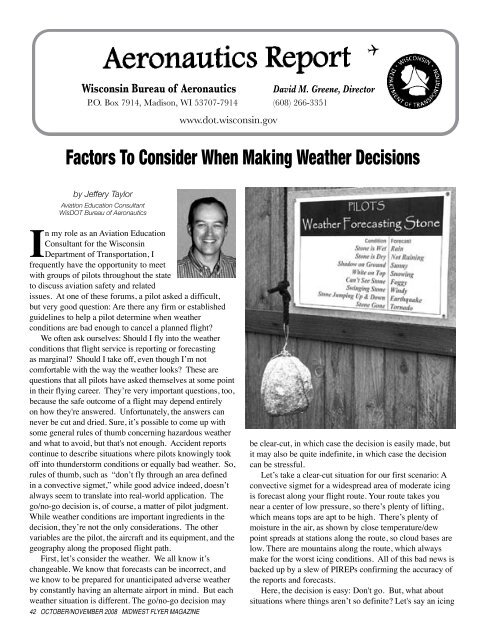PDF Version October November 2008 - Midwest Flyer
PDF Version October November 2008 - Midwest Flyer
PDF Version October November 2008 - Midwest Flyer
Create successful ePaper yourself
Turn your PDF publications into a flip-book with our unique Google optimized e-Paper software.
������������������� ����������� �������������������������<br />
������������������������������������� ��������������<br />
Factors To Consider When Making Weather Decisions<br />
by Jeffery Taylor<br />
Aviation Education Consultant<br />
WisDOT Bureau of Aeronautics<br />
In my role as an Aviation Education<br />
Consultant for the Wisconsin<br />
Department of Transportation, I<br />
frequently have the opportunity to meet<br />
with groups of pilots throughout the state<br />
to discuss aviation safety and related<br />
issues. At one of these forums, a pilot asked a difficult,<br />
but very good question: Are there any firm or established<br />
guidelines to help a pilot determine when weather<br />
conditions are bad enough to cancel a planned flight?<br />
We often ask ourselves: Should I fly into the weather<br />
conditions that flight service is reporting or forecasting<br />
as marginal? Should I take off, even though I’m not<br />
comfortable with the way the weather looks? These are<br />
questions that all pilots have asked themselves at some point<br />
in their flying career. They’re very important questions, too,<br />
because the safe outcome of a flight may depend entirely<br />
on how they're answered. Unfortunately, the answers can<br />
never be cut and dried. Sure, it’s possible to come up with<br />
some general rules of thumb concerning hazardous weather<br />
and what to avoid, but that's not enough. Accident reports<br />
continue to describe situations where pilots knowingly took<br />
off into thunderstorm conditions or equally bad weather. So,<br />
rules of thumb, such as “don’t fly through an area defined<br />
in a convective sigmet,” while good advice indeed, doesn’t<br />
always seem to translate into real-world application. The<br />
go/no-go decision is, of course, a matter of pilot judgment.<br />
While weather conditions are important ingredients in the<br />
decision, they’re not the only considerations. The other<br />
variables are the pilot, the aircraft and its equipment, and the<br />
geography along the proposed flight path.<br />
First, let’s consider the weather. We all know it’s<br />
changeable. We know that forecasts can be incorrect, and<br />
we know to be prepared for unanticipated adverse weather<br />
by constantly having an alternate airport in mind. But each<br />
weather situation is different. The go/no-go decision may<br />
42 OCTOBER/NOVEMBER <strong>2008</strong> MIDWEST FLYER MAGAZINE<br />
���������������������<br />
T Maskhead.indd 1 7/20/08 12:22:1<br />
be clear-cut, in which case the decision is easily made, but<br />
it may also be quite indefinite, in which case the decision<br />
can be stressful.<br />
Let’s take a clear-cut situation for our first scenario: A<br />
convective sigmet for a widespread area of moderate icing<br />
is forecast along your flight route. Your route takes you<br />
near a center of low pressure, so there’s plenty of lifting,<br />
which means tops are apt to be high. There’s plenty of<br />
moisture in the air, as shown by close temperature/dew<br />
point spreads at stations along the route, so cloud bases are<br />
low. There are mountains along the route, which always<br />
make for the worst icing conditions. All of this bad news is<br />
backed up by a slew of PIREPs confirming the accuracy of<br />
the reports and forecasts.<br />
Here, the decision is easy: Don't go. But, what about<br />
situations where things aren’t so definite? Let's say an icing

















